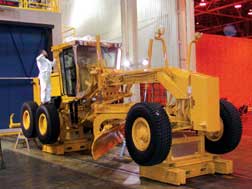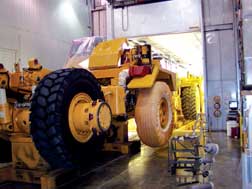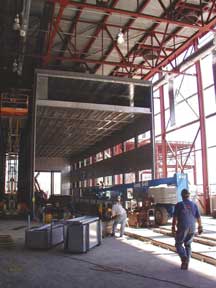Caterpillar-Rethinking

The constant attention that leading manufacturers are paying to building upon competitive advantages will, over time, drive the rethinking of conventional wisdom. A practical example of this, involving large-scale painting operations, occurred between 2000 and 2001 at Caterpillar's Mining and Construction Equipment (MCE) division. The experience illustrates why Caterpillar now opts for an internally managed approach to the design or redesign of many of the company's paint-system assets around the world.
As part of a cost-reduction and building-consolidation project launched by MCE management in 2000, all products painted in the division's two large painting systems had to be accommodated in one location. Some of the individuals involved in the project initially wondered how this could be done, since the idea, coupled with substantially reducing the floor space, seemed counter-intuitive. Wouldn't the new paint line have to be quite a bit larger than either one of its parts?
And since the area that was being upgraded for enhanced capacity was a 10-year-old robotic application system (bought for around $28 million in 1990), some team members expected that the effort would be very expensive.
As Doug Russell, project manager from Caterpillar's Paint Finishing Group (PFG), put it, "Other options had to be explored. We wanted to begin with a clean slate and rethink all of the small but critical details of the painting process. Rather than making what had been done previously the default starting point, we wanted to explore what had been learned over the last 10 years in Decatur and elsewhere that had worked the best for Caterpillar in terms of overall cost and operational efficiency."

Learning from adversity: a new approach to engineering
A Caterpillar paint-system project in England in 1997 required some real creativity. Project constraints such as scarce factory floor space and extremely limited capital budgets were the catalysts for innovation. They were also the catalyst for what now is the PFG.
Located in East Peoria, IL, PFG has grown into a small, flexible staff of five full-time employees, its growth coinciding with several paint system designs and installations worldwide and the development of innovative methods of capital equipment procurement directed at a single target: achieving the lowest possible per-unit painting cost.
To the surprise of those involved in the England project, and subsequent project, PFG's capital procurement process enabled its worldwide clients to select the lowest total-cost painting option available. More interesting, however, is that for about half the targeted per-unit cost, each client was also choosing a coating option that provided paint finish performance far surpassing the preproject benchmarks and/or the targeted paint performance and quality specifications.
How is this done? In a nutshell, the devil-and a large portion of true operating costs-are found in the details of paint finishing and material handling system designs. These details are essential to achieving the desired lowest possible per-unit paint cost. And, more than anything else, rigorous attention to the painting process and equipment detail has been key to PFG's successes.
More specifically, the focus of each project is generally on the following: one, understanding the details of the current and potential processes being examined; two, understanding all of the costs (and drivers) related to the different systems examined for coating and curing painted product; and three, performing detailed process testing prior to system design. This greatly reduces uncertainty by proving in advance whether the design and any potential "outside of the box" ideas will work to satisfy customer needs flexibly over the long term.
In context, the necessary level of predesign testing is not "expensive" in terms of dollars but can potentially become, if anything, a time issue. Example after example, however, shows that this is time and money well spent because it can significantly affect design direction and the system's physical dimensions. Caterpillar tests its systems at various sites, including ITW BGK (electric IR), Catalytic Industrial Systems (gas IR) and Nordson (powder booths and spray guns) locations.
As desired by the customer, PFG can then supply and manage a clear and nontraditional capital bid specification and quotation process among numerous prequalified equipment suppliers. With informative and specific equipment quotations in hand, the value of the approach takes shape as the group can then choose among equivalent equipment and competitive prices.
Making a complex project manageable by breaking it up into distinct and understandable parts (paying close attention to the specifics of each) is a critical factor in the stewardship of large projects. Significant experience shows that much less predesign process testing and validation occurs, which can increase the risk of major glitches after the system's switch is thrown for startup. At that point, the client may need to spend more money on add-on equipment to fix a possible oversight that some would have considered a "minor" undocumented process detail.
The upshot of this attention to detail, testing and the bid process is later seen in the positive impact on the budgets of projects. Final costs are transparent because all of the work is done with an "open book" understanding between PFG and its client regarding capital cost and design. In recognition of the importance of data-driven decisions, in mid-2002 the group's founder, John Spangler, earned a Six Sigma Black Belt (an internal facilitator of project-oriented, data-based decision-making teams), working primarily on paint-process-related projects.
Finally, the value of PFG's process has been apparent enough within the company to prompt Caterpillar to seek U.S. patent protection for PFG's bill of material (BOM) capital-procurement methodology as a useful business practice.
Bringing it all together in Decatur
With MCE directing the paint team to reduce operating costs and consolidate the two paint operations into one, painting of all of the plant's finished product was to occur in a proposed line floor space of 22,000 square feet, half of the footprint previously used.
Complicating these expectations was the team's need to accomplish all of its goals within 14 months, provide increased throughput capability, reduce manpower levels compared to the robotic paint line and cut the per-unit cost of painting by about 50%.
The bar had been set, and it was high.
Formed in the summer of 2000, the Decatur paint project team consisted of numerous key people. Doug Russell, PFG's project engineering team leader, led the paint system's design, validation and construction efforts. Working under the materials technology manager, Mike Olmstead, several MCE management personnel were appointed to facilitate the needed building modifications and oversee the regulatory permitting and personnel issues. Additionally, PFG retained the services of what is now Ghafari ESG (Dearborn, MI) to assist with AutoCAD and related design work.
Taking seriously their goal to minimize preconceived ideas by starting with a clean slate, the team began by asking some very fundamental questions. One was, "Is there any reason why this process requires robotic application of a liquid, two-component urethane finish?"
There was general support of the idea that robotic application ensures more consistent paint application, minimizing the volume of paint consumed. But there are more considerations, though, and capital cost, for example, was one factor that played a major role in the final design direction. It was unclear without much further study exactly what a capable new robotic system might cost, but from past experience it was expected to be substantial.

Reconfiguring what works
Outside of Decatur, IL, there aren't a lot of places that manufacture and paint, in a single location, vehicles or vehicle components for very large finished products. Examples of "very large" include the Caterpillar 797B mining truck, which weighs 1.4 million pounds, a 53-foot-long Cat 657 wheel tractor scraper and the 52-foot-long Cat 24H motor grader. However, it made sense for the team to look for some initial perspective at divisions of Caterpillar where other very large things are painted. Fortunately, one of these places was in East Peoria, IL, which is a 90-minute drive from Decatur.
Not wishing to reinvent the wheel, several groups from MCE toured the indexing vehicle, manual paint-application system at the Track-Type Tractor Division's (TTTD) East Peoria plant. Most sizes of Cat's familiar bulldozing tractors are assembled and painted at the site.

Product size variability was not insurmountable, even considering the limited footprint available. The masking of tires was possible and was less of a labor burden (and expense) than was originally thought. Lastly, based on real-scale tests, painting heavy parts using catalytic gas infrared ovens made by Catalytic Industrial Systems (Independence, KS) showed that curing a Valspar (Minneapolis) two-component polyurethane paint in key areas (the areas that needed to be walked on soon after curing) was comfortably feasible within the range of desired indexing intervals.
A system takes shape
To develop a modified TTTD line in Decatur, the team worked with Ghafari ESG and Architectural Expressions (Decatur) to design the necessary equipment and produce building drawings for preparation of the project bid specification. With level product volume expectations and the tandem goals of reducing operating and labor costs for a manual vs. robotic paint application, some adjustments in design had to be made.
Based on a derived target throughput requirement that indexes the 500-foot-long system every 35 minutes and the goal of producing consistent and controlled finish quality, a number of modifications were made to the "typical" system design and incorporated into the bid specification. Throughout each 51-foot-long section-including load, prep, wash, dry-off, masking, paint and curing-the entire paint system is controlled by PC-based SCADAware control software.
SCADAware software drives several large digital marquees visible from all locations on the line, providing operations people with information ranging from real-time updates on line indexing status to when it's time for lunch. The Valspar two-component paint is processed by Graco (Minneapolis) equipment. Precision Mix II units provide mixed primer, topcoat and special-color paints as needed to painters stationed in man lifts, a 3-foot recessed pit and floor-level stations. Painters utilize Graco air-assisted airless guns in Paint Station No. 1 for underneath (and prime paint on some sub-assemblies) and air-assisted electrostatic guns for the topcoating operation in Paint Station No. 2. Floor-space consumption in the building addition is minimized and the indexing movement of large product on dollies added to by the prewash and post de-mask areas' use of large turntables to enable turning fully assembled product dollies 90 degrees.
The aggressive design-to-start-up schedule of 14 months would only be possible with great attention paid to project management scheduling and effective team communications with design firms and installation contractors. With PFG serving in a general contractor role during installation, it was especially important that Doug Russell help coordinate all activities and clear lines of communication among everyone involved. One unusual example of this occurred when the paint booths were being constructed at the same time as the building addition housing the line (see picture above). Fortunately, installation contractor Christy-Folz (Decatur), pretreatment and spray booth fabricator Gallagher-Kaiser (Detroit), Ghafari ESG, Archi-tectural Expressions and others set a very high standard for effectively communicating ongoing schedule changes among themselves.
Once the system was installed, demonstrated performance became the day-to-day return on the effective project design and equipment procurement. Advancements made by the SCADAware control of the completed system are substantial and include an interesting combination of control technology and workforce optimization. The SPC control and monitoring of paint and solvent usage is handled by Autoquip's Autolog software, which collects and records real-time data of individual units. This is useful not only for quality assurance purposes but also for environmental permit reporting purposes.
Since full production began in December 2001 (on schedule and $900,000 under the $6.5 million capital budget), Decatur's MCE paint operation met or surpassed every cost and efficiency goal set for the team 14 months before. Paint finish quality has never been higher, and the paint line staff consistently uses two fewer people per shift to paint in two shifts what formerly required three shifts plus overtime, working most Saturdays. Per-unit usage of paint flush solvent is approximately half of what it was and per-unit usage of paint has also been significantly reduced.
At the end of the day, the gains made by an empowered group of MCE employees and PFG staff have served as an outstanding example, reinforcing Caterpillar's novel approach to the acquisition of paint and material-handling systems. PFG has subsequently completed other internal and external projects, most recently a large and challenging system in Mexico, all with similar results. These results will be chronicled in an upcoming issue.
Looking for a reprint of this article?
From high-res PDFs to custom plaques, order your copy today!




